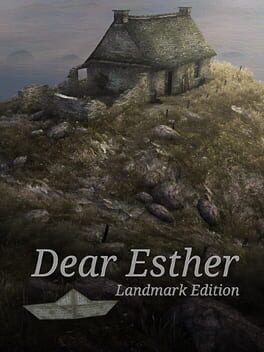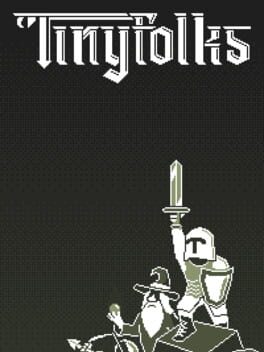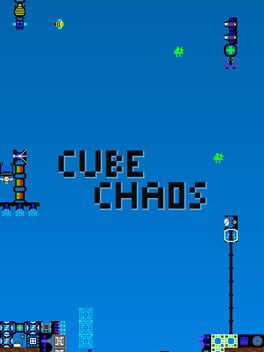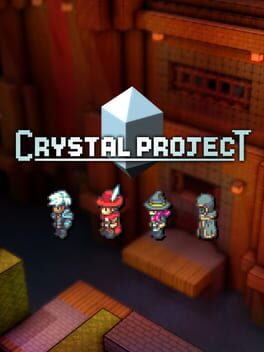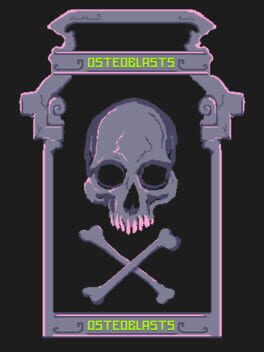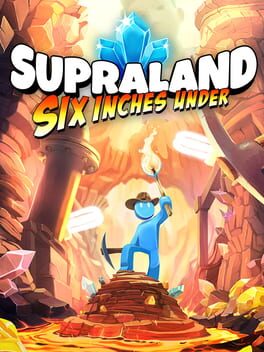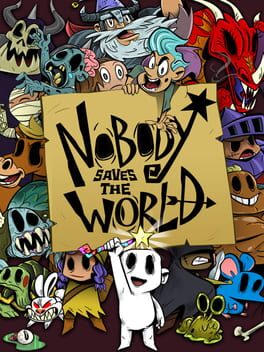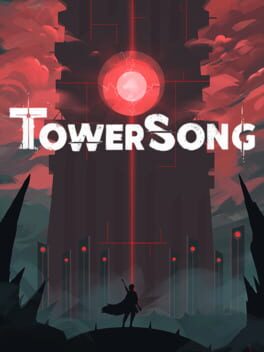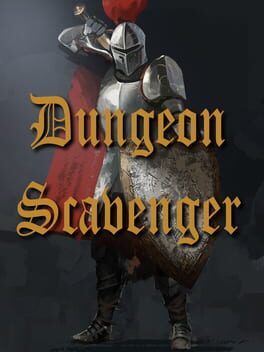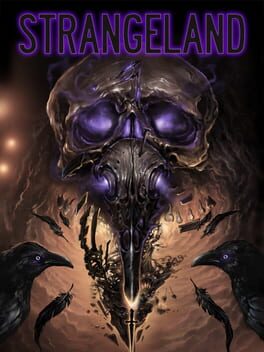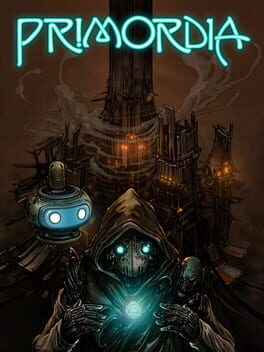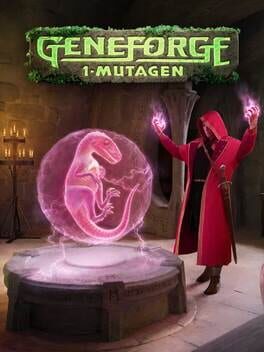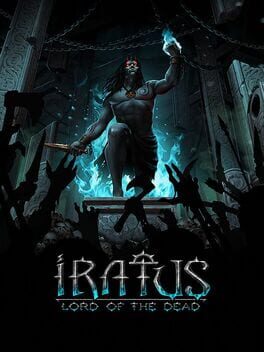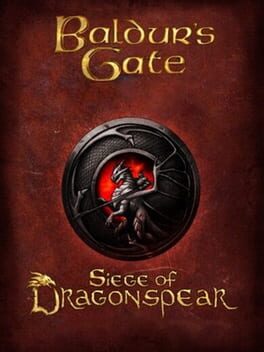jademonkey
Gorgeous experience. Great scenery, beautiful sound track, and I very much enjoyed the use of language. They leaned a bit too hard into metaphor and letting every player have their own interpretation for my tastes. I think the game would have benefited from a little less ambiguity, at least towards the end. I didn't quite get the emotional payoff I was hoping for. Still, I enjoyed my time with Dear Esther and would recommend it.
2022
Tinyfolks takes the Darkest Dungeons formula and condenses it down to a bite-size 4 hour package, maintaining most of the fun and losing all of the tedium. Despite the small form factor, there are enough options to explore to warrant a couple of playthroughs, which is exactly what I'd look for in this sort of release. It may not have Wayne June delivering banger lines one-after-another, but the audio and visual design manages to be very charming nonetheless. Highly recommended - it's a great way to spend an afternoon or two.
2023
2022
I got a bit annoyed with the awkward jump puzzles leading to frustrating extra encounters. It's been a couple of years and there are quite a few updates along with mod support nowadays. I really wanted to like the game, so maybe I'll give it another whirl at some point and see if I can find a combination of mods that works for me.
2021
Well, this was a fun little RPGmaker experience. Great visuals and audio. I loved the color choices and enemy design. The story felt more like an abstract set of ideas to set a mood than anything completely coherent, but the broad strokes still painted enough of a picture to avoid feeling like nonsense. The combat, stats, and equipment systems were odd, but held together well enough for a 12 hour game. With most stats governing both offense and defense of a certain type, it felt a bit difficult to specialize. Luckily, there were enough intricacies between the variety of passive abilities and the equipment providing both stats and active abilities to keep me engaged for the short run time.
Overall, it was a good time all about the spooky vibes, and I'm down for that.
Overall, it was a good time all about the spooky vibes, and I'm down for that.
2024
Tower Song is an enjoyable small indie RPG.
The standout feature is the combat design, with each character having their own unique systems. One uses tarot cards, another has a sniper rifle with ammunition, another changes between elemental stances, and so on. Fights feel a lot more dynamic than the standard set by classic Dragon Quest and Final Fantasy.
I enjoyed the characters. The plot and setting were both very cool, but a bit lean. What's there is certainly worth the money, especially if you have interest in replaying with a different main character to see new dialogue and mix up the gameplay a bit.
Character and monster designs are great, and the environments are substantially better than most RPGmaker titles. I really enjoyed the music, though the overall sound design and mixing was a bit off at times.
I recommend the game for anyone who likes shorter RPGs with that indie flair and lots of unique ideas.
The standout feature is the combat design, with each character having their own unique systems. One uses tarot cards, another has a sniper rifle with ammunition, another changes between elemental stances, and so on. Fights feel a lot more dynamic than the standard set by classic Dragon Quest and Final Fantasy.
I enjoyed the characters. The plot and setting were both very cool, but a bit lean. What's there is certainly worth the money, especially if you have interest in replaying with a different main character to see new dialogue and mix up the gameplay a bit.
Character and monster designs are great, and the environments are substantially better than most RPGmaker titles. I really enjoyed the music, though the overall sound design and mixing was a bit off at times.
I recommend the game for anyone who likes shorter RPGs with that indie flair and lots of unique ideas.
2020
Dungeon Scavenger is a super stripped down 1v1 dungeon crawler that can be completed in a ~5 hours. You click around the dungeon on a 2D map, get some choose-one-of-3-outcomes random events, open some trapped chests or fight some monsters (but only one at a time). There's a bunch of classes to choose from, giving a couple of active spells and some passives each. Everyone can tame monsters by using consumable scrolls, which is nice little feature, I suppose.
You upgrade your town each time you win, there's extra floors from the DLC, and multiple difficulty levels, but there's just not quite enough going on to justify more than the 5 hours. It's not a great game on any level, but I enjoyed my afternoon with it well enough.
You upgrade your town each time you win, there's extra floors from the DLC, and multiple difficulty levels, but there's just not quite enough going on to justify more than the 5 hours. It's not a great game on any level, but I enjoyed my afternoon with it well enough.
2021
There are a lot of game design decisions in Biomutant that left me scratching my head. Character progression was off, with too many upgrades for powerful playstyles and not enough for weaker ones. Loot progression was mishandled -- I only ended up finding 2-3 upgrades on the weapon type I liked in the 25 hours I played. Assets were blatantly and distractingly copied and pasted across zones in many occasions. The combat could be clunky at times, and the balance was just off between melee and ranged weapons. The story line was also very minimal.
Despite all of that, I had a great time with Biomutant. The environments were gorgeous, and the world was fun to explore. The character and creature designs were unique and endearing. Despite being clunky at times, the combat was overall very fun, allowing you to combo gun and melee and pepper in psionic and mutagenic abilities. The storyline and characters were charming. The various mounts and vehicles were particularly enjoyable ways to traverse the landscapes.
I think Biomutant shares a similar fate to the original Fable -- it promised a world of innovation, but only delivered a charming action RPG with a few gimmicks. I'm fine with that. I wish the systems were a bit more fleshed out and impactful, but in the end, I enjoyed myself and the game put a smile on my face.
I'm giving Biomutant a 3.5/5. Most of the individual components of Biomutant were 2/5 or maybe 3/5, but, for me, it just came together to be an all around good time despite its shortcomings. A game only needs to do a couple of things really well, as long as its mediocre aspects don't detract too heavily from the experience. Biomutant nailed the atmosphere and environments, while delivering plenty of fun along the way.
Despite all of that, I had a great time with Biomutant. The environments were gorgeous, and the world was fun to explore. The character and creature designs were unique and endearing. Despite being clunky at times, the combat was overall very fun, allowing you to combo gun and melee and pepper in psionic and mutagenic abilities. The storyline and characters were charming. The various mounts and vehicles were particularly enjoyable ways to traverse the landscapes.
I think Biomutant shares a similar fate to the original Fable -- it promised a world of innovation, but only delivered a charming action RPG with a few gimmicks. I'm fine with that. I wish the systems were a bit more fleshed out and impactful, but in the end, I enjoyed myself and the game put a smile on my face.
I'm giving Biomutant a 3.5/5. Most of the individual components of Biomutant were 2/5 or maybe 3/5, but, for me, it just came together to be an all around good time despite its shortcomings. A game only needs to do a couple of things really well, as long as its mediocre aspects don't detract too heavily from the experience. Biomutant nailed the atmosphere and environments, while delivering plenty of fun along the way.
2021
This is absolute poetry. Beautifully written and powerfully atmospheric. I could feel just how much grief went into the creation of this deeply-personal game. I can't imagine many would make it through without feeling a strong resonance with at least a scene or two.
I love how unflinchingly bizarre the world of Strangeland is. Many scenes reminded me in the best way possible of the less-gratuitous (in terms of shock-value, at the least) David Firth animations, albeit far more heady; particularly the cicada and teratoma interactions. Every corner of Strangeland is dripping with Giger and Poe and various mythological and biblical allusions. These references thankfully serve to strengthen the unique narrative of Strangeland -- it never feels like a hollow vessel for previous works. In fact, there's a great comment or two in the game about leaning heavily on quotation.
The puzzles and interactive gameplay elements serve their purpose well in creating a connection to the narrative. I never felt too stuck or frustrated, and a simple call to the operator could point me in the right direction if I'd overlooked a cue.
I'm not particularly keen on replaying this one any time too soon, however. It was just a lot to take in! I finished Primordia earlier this week, and will almost certainly return to it sooner than this, despite the excellent evolution in design. All of that being said, I'm very happy to have had the experience and give Strangeland my highest recommendation.
I love how unflinchingly bizarre the world of Strangeland is. Many scenes reminded me in the best way possible of the less-gratuitous (in terms of shock-value, at the least) David Firth animations, albeit far more heady; particularly the cicada and teratoma interactions. Every corner of Strangeland is dripping with Giger and Poe and various mythological and biblical allusions. These references thankfully serve to strengthen the unique narrative of Strangeland -- it never feels like a hollow vessel for previous works. In fact, there's a great comment or two in the game about leaning heavily on quotation.
The puzzles and interactive gameplay elements serve their purpose well in creating a connection to the narrative. I never felt too stuck or frustrated, and a simple call to the operator could point me in the right direction if I'd overlooked a cue.
I'm not particularly keen on replaying this one any time too soon, however. It was just a lot to take in! I finished Primordia earlier this week, and will almost certainly return to it sooner than this, despite the excellent evolution in design. All of that being said, I'm very happy to have had the experience and give Strangeland my highest recommendation.
2012
It's not quite as emotionally hard hitting as the later Blackwell titles, but it's more thematically up my alley -- I work in machine learning/computer vision and Primordia touches on quite a few of the topics my grad school friends and I would riff on to avoid actually doing our work. The writing, music, art, voice acting, etc. are all also absolutely on point. My only complaint is a little bit of frustrating pixel hunting here and there. One instance almost lead to me missing a really nice touch in my preferred ending, but I caught it while checking out the other endings. Still, a minor problem compared to how much Primordia got right.
2021
This is a remake of Spiderweb's 2001 cult classic Geneforge. I'd always wanted to play the game growing up, but that was a time when we were still wary of purchasing games online. I ended up playing through the free demo a few times, but never got ahold of the actual game.
The setting still feels fresh 20 years later. You're playing as an initiate "shaper" -- a magical sect with the power to create life. While travelling to your training, your ship is destroyed. You wash up on an island that has been declared barred by the shapers, on pain of death to anyone who goes there. The island, however, isn't empty. Lifeforms created by shapers prior to their barring of the island have formed their own societies on the island in the absence of their creators. Some want to be treated as equals, some want to return to being obedient, and others want revenge for being used and abandoned. Of course, the mystery of why the island was originally barred is the driving force behind the story.
You have access to the standard variety of RPG spells and weapons, but, as a shaper, you can also create lifeforms to fight for you. This is the games main mechanical differentiator. There are about 10 different types of creatures you can create and upgrade, with up to 7 joining you in combat at a time. There's a good variety of melee, ranged, magic, buffing, cursing, etc. abilities available to the creatures, so the customization is on point.
There are a couple of big issues that led to me dropping the game 30 hours in, unfortunately. The biggest being that there is simply too much meaningless combat. There is something like 80 zones to explore, and a substantial portion of those have you fighting wave after wave of enemies, for very little reward. The combat is fairly bog-standard CRPG turn based affair, so this wears thin rather quickly.
Much of the game wasn't really updated to 2021 standards. For example, the interface is still clunky with tiny little tiles in combat, leading to surprisingly easy mislicks. Battle information and ability descriptions aren't readily available. Geneforge's version of lockpicks, "Living Tools", are not widely available, leading to the old "open a chest and reload if you don't care about the contents", even if you are raising your mechanics skill to limit the amount you need to use. These issues are largely minor or even trivial issues, but they are amplified by the amount of time you have to spend dealing with them.
All in all, there's a lot of charm and a strong core of exploration and narrative. I would have absolutely loved Geneforge if I'd been able to play the full game back in 2001, when I had more time and patience for endless combat in games. As it is now, I'm going to move on to something that's a bit more of a focused experience. I'll probably read about the last 1/3 of the game, though. The lore is worth it, but the game just wasn't fun on the whole.
The setting still feels fresh 20 years later. You're playing as an initiate "shaper" -- a magical sect with the power to create life. While travelling to your training, your ship is destroyed. You wash up on an island that has been declared barred by the shapers, on pain of death to anyone who goes there. The island, however, isn't empty. Lifeforms created by shapers prior to their barring of the island have formed their own societies on the island in the absence of their creators. Some want to be treated as equals, some want to return to being obedient, and others want revenge for being used and abandoned. Of course, the mystery of why the island was originally barred is the driving force behind the story.
You have access to the standard variety of RPG spells and weapons, but, as a shaper, you can also create lifeforms to fight for you. This is the games main mechanical differentiator. There are about 10 different types of creatures you can create and upgrade, with up to 7 joining you in combat at a time. There's a good variety of melee, ranged, magic, buffing, cursing, etc. abilities available to the creatures, so the customization is on point.
There are a couple of big issues that led to me dropping the game 30 hours in, unfortunately. The biggest being that there is simply too much meaningless combat. There is something like 80 zones to explore, and a substantial portion of those have you fighting wave after wave of enemies, for very little reward. The combat is fairly bog-standard CRPG turn based affair, so this wears thin rather quickly.
Much of the game wasn't really updated to 2021 standards. For example, the interface is still clunky with tiny little tiles in combat, leading to surprisingly easy mislicks. Battle information and ability descriptions aren't readily available. Geneforge's version of lockpicks, "Living Tools", are not widely available, leading to the old "open a chest and reload if you don't care about the contents", even if you are raising your mechanics skill to limit the amount you need to use. These issues are largely minor or even trivial issues, but they are amplified by the amount of time you have to spend dealing with them.
All in all, there's a lot of charm and a strong core of exploration and narrative. I would have absolutely loved Geneforge if I'd been able to play the full game back in 2001, when I had more time and patience for endless combat in games. As it is now, I'm going to move on to something that's a bit more of a focused experience. I'll probably read about the last 1/3 of the game, though. The lore is worth it, but the game just wasn't fun on the whole.
I did a run of the tutorial difficulty and half of a run on standard, for ~15 hours of play time.
Iratus follows the Darkest Dungeon formula fairly closely, but instead of trying to survive eldritch horrors, you are the horror. There's a lot to like about the idea, and Iratus does a good enough job with the units and combat itself. In fact, I think it actually does a better job than Darkest Dungeons in those regards.
Unfortunately, nothing else is quite up to par. The voice-overs have none of Wayne June's charm, and are sometimes even outright grating or uncomfortable. The artwork is serviceable, but not particularly memorable. There are some issues with the English in a few ability or item descriptions, which occasionally make it difficult to determine how things function. It feels like they had a writer fluent in English handle most of the game, but then a different dev went back in and added a few things without putting them through the normal writing process.
Most damningly, Iratus misses out on one of the most necessary characteristics for a roguelike -- variance between runs. Once you unlock a unit type, you are always able to build it as long as you have the necessary resources, and you generally will. You'll generally even be able to make a new unit of the same level as the ones you've been using due to enemy brain drops, further reducing any feelings of uniqueness to a run. There are few truly random events, and they rarely have long lasting effects. I don't think I saw a single item in the second run that I hadn't received in the first. As far as I can tell, you'll fight the same bosses each time as well. Each run needs to feel substantially different for a roguelike to be worth it-- otherwise, I'd rather just play a game that's designed for a single playthrough. Games like ToME handle that mainly through having a massive variety in classes, and DCSS/Brogue through forcing you to react to what's available in a run. Iratus doesn't really do either.
If you enjoy the Darkest Dungeon formula and just want more of that style of combat, I think Iratus is worth a shot for you. Similarly, if you prefer less variance, you may get more out of the game. For me, there just wasn't quite enough run variety or charm to counterbalance the inherently frustrating nature of this style of game.
Iratus follows the Darkest Dungeon formula fairly closely, but instead of trying to survive eldritch horrors, you are the horror. There's a lot to like about the idea, and Iratus does a good enough job with the units and combat itself. In fact, I think it actually does a better job than Darkest Dungeons in those regards.
Unfortunately, nothing else is quite up to par. The voice-overs have none of Wayne June's charm, and are sometimes even outright grating or uncomfortable. The artwork is serviceable, but not particularly memorable. There are some issues with the English in a few ability or item descriptions, which occasionally make it difficult to determine how things function. It feels like they had a writer fluent in English handle most of the game, but then a different dev went back in and added a few things without putting them through the normal writing process.
Most damningly, Iratus misses out on one of the most necessary characteristics for a roguelike -- variance between runs. Once you unlock a unit type, you are always able to build it as long as you have the necessary resources, and you generally will. You'll generally even be able to make a new unit of the same level as the ones you've been using due to enemy brain drops, further reducing any feelings of uniqueness to a run. There are few truly random events, and they rarely have long lasting effects. I don't think I saw a single item in the second run that I hadn't received in the first. As far as I can tell, you'll fight the same bosses each time as well. Each run needs to feel substantially different for a roguelike to be worth it-- otherwise, I'd rather just play a game that's designed for a single playthrough. Games like ToME handle that mainly through having a massive variety in classes, and DCSS/Brogue through forcing you to react to what's available in a run. Iratus doesn't really do either.
If you enjoy the Darkest Dungeon formula and just want more of that style of combat, I think Iratus is worth a shot for you. Similarly, if you prefer less variance, you may get more out of the game. For me, there just wasn't quite enough run variety or charm to counterbalance the inherently frustrating nature of this style of game.
This review contains spoilers
After seeing so much negativity toward SoD over the last few years, I went in with really low expectations. I'm surprised to say, I actually like it better than Baldur's Gate 1.
For some context, I've installed a few of the larger overarching mods like Enhanced Edition Trilogy and Sword Coast Stratagems, along with a few rules tweak packs and the Unearthed Aracana series of class revision mods. This evens out a lot of the rougher edges and is much more satisfying for my love of tinkering with character builds, but otherwise shouldn't affect my review too much.
The art direction, both in terms of level design and music, is excellent. They managed to keep the feel of the old infinity engine games while bringing in modern lighting and capability to render more actors on screen. The areas of Baldur's Gate you visit at the start really feel like a bustling, seedy city in a way that the original games simply couldn't achieve, and the lighting in caves and tombs is absolutely on point. The set pieces in the levels are well done. The underground river map is a particular standout, with an almost mystic glow around the river and one portion overrun with the verdant overgrowth brought about by a shadow druid.
I generally found the encounter design to be quite good. There were several large scale battles involving dozens of allies and enemies in addition to your own party. It felt great to drop down some AoE buffs like haste and blessing and watch your army become a truly terrifying force. Their were some great ambush scenarios, especially in some random events that could pop up when travelling between locations. Fighting off a group of assassins in an anti-magic field was terrifying, and a huge step forward from Baldur's Gate's "you are suddenly surrounded by 8 archers". Of course, this is all bolstered by my enjoyment of mid-level D&D mechanics. I find the lower levels to a bit overly variable and lacking in choices, and the higher levels to dip into the overly complex. I honestly wouldn't be surprised if the strength of mid-level D&D wasn't part of the design process that led to Siege of Dragonspear.
Combat was, at times, frustrating, though. While the critical story-centric large scale battles and the more hand-crafted unique scenarios felt great, the average throwaway encounter felt a bit overcrowded. I'd run into a group of spiders and think to myself "Ok, not too bad. There's about ten total with a mix of sword, wraith and phase. I should get through this with just a little bit of spell and consumable use" and suddenly a pocket plane clown car's worth of oozes would pile in from the fog of war. Now, to some degree I brought this on myself. I played on Hardcore difficulty and, as mentioned before, had installed Sword Coast Stratagems. I also didn't have a full arcane caster (Imoen i miss u) with me, so that left my priests and druid to pick up a lot of slack.
The overall story was exactly what I signed up for. It bridged the events between Baldur's Gate 1 and 2, while introducing a solid enough story to maintain its own identity. It's a D&D game telling D&D stories, so it's trope-y, and you can see the twists coming for a mile away. I don't think predictability is inherently a bad thing, and, in this case, was probably necessary, given the game's interstitial nature. Siege of Dragonspear did a very competent job at filling in the vague "circumstances much darker than anyone would have believed" mentioned in Shadow of Amn's opening movie, while also giving you a modules worth of adventure in Caelar Argent's story. Even if I had mostly guessed Argent's final fate, I still enjoyed watching the particulars of how it unfolded. Player agency was perhaps a bit stymied at times and I'm not sure how much my choices mattered, but I wasn't particularly bothered by it. Even Baldur's Gate 1 would outright insta-kill you for trying to kill Sarevok out of turn. There was much less freedom to explore between major story events than BG 1 or 2, but, again, given the interstitial nature of the game, I think this was for the best. I also greatly enjoy a focused story where you don't feel like you run off spending months on odds and ends while the world is hanging in balance.
While I liked the overall narrative structure and story beats, I found the actual writing to be a bit hamfisted. Some interactions really left me rolling my eyes. In one "side quest" you have a conversation with a soldier who struggling to cope with the fear caused by being stuck in a siege situation. He's losing his nerve as you speak with him, but quickly does a 180 when you spout a generic platitude at him. Just one platitude. And then you get 6000 experience! Subtlety was certainly not this games forte. It could be frustrating how much the game felt like it had to spell out plot points to you directly, rather than leaving some to implication. Major and minor characters did manage to have their own voices, despite falling a bit too much into tropes, such as "drunken dwarf craftsman" or "hapless gnome in over his head in the military".
I played as a female charname and pursued the romance with Corwin. Corwin was a very believable and grounded character, which was a nice change of pace from the usual "fantasy" character present in these games. Corwin is single mother, working as a Captain in the Flaming Fist, trying to make enough money to give her daughter a comfortable life, while worrying about being away so often. She's brash and in your face, but responds in a very believable way when you consider her motivations and fears. The romance itself was handled slowly and tastefully, showing two adults who become interested in each other while being forced together. It wasn't perhaps the most exciting tale, but it was a nice subplot to have. Corwin could be self-righteous at times, which built to a great scene where Dorn, the half-orc who gladly sold his soul to a devil for power, calls out her motivations for continuing to work as mercenary in her situation and compares it to his own choices. All that is to say, despite much of the dialogue writing falling a bit flat, there was a nice human element to it and they did pull off some good character drama at times.
In the end, Siege of Dragonspear was well worth my time and I'll include it in future playthroughs of the saga. It wasn't a "necessary" addition, but I think it smooths out the experience going from the first game to the second, and provides a fun "module" with Caelar Argents story. If you enjoy Infinity Engine, and don't mind a little incongruence in writing style and presentation between the Baldur's Gate 1 and 2, I'd recommend giving Dragonspear a shot.
For some context, I've installed a few of the larger overarching mods like Enhanced Edition Trilogy and Sword Coast Stratagems, along with a few rules tweak packs and the Unearthed Aracana series of class revision mods. This evens out a lot of the rougher edges and is much more satisfying for my love of tinkering with character builds, but otherwise shouldn't affect my review too much.
The art direction, both in terms of level design and music, is excellent. They managed to keep the feel of the old infinity engine games while bringing in modern lighting and capability to render more actors on screen. The areas of Baldur's Gate you visit at the start really feel like a bustling, seedy city in a way that the original games simply couldn't achieve, and the lighting in caves and tombs is absolutely on point. The set pieces in the levels are well done. The underground river map is a particular standout, with an almost mystic glow around the river and one portion overrun with the verdant overgrowth brought about by a shadow druid.
I generally found the encounter design to be quite good. There were several large scale battles involving dozens of allies and enemies in addition to your own party. It felt great to drop down some AoE buffs like haste and blessing and watch your army become a truly terrifying force. Their were some great ambush scenarios, especially in some random events that could pop up when travelling between locations. Fighting off a group of assassins in an anti-magic field was terrifying, and a huge step forward from Baldur's Gate's "you are suddenly surrounded by 8 archers". Of course, this is all bolstered by my enjoyment of mid-level D&D mechanics. I find the lower levels to a bit overly variable and lacking in choices, and the higher levels to dip into the overly complex. I honestly wouldn't be surprised if the strength of mid-level D&D wasn't part of the design process that led to Siege of Dragonspear.
Combat was, at times, frustrating, though. While the critical story-centric large scale battles and the more hand-crafted unique scenarios felt great, the average throwaway encounter felt a bit overcrowded. I'd run into a group of spiders and think to myself "Ok, not too bad. There's about ten total with a mix of sword, wraith and phase. I should get through this with just a little bit of spell and consumable use" and suddenly a pocket plane clown car's worth of oozes would pile in from the fog of war. Now, to some degree I brought this on myself. I played on Hardcore difficulty and, as mentioned before, had installed Sword Coast Stratagems. I also didn't have a full arcane caster (Imoen i miss u) with me, so that left my priests and druid to pick up a lot of slack.
The overall story was exactly what I signed up for. It bridged the events between Baldur's Gate 1 and 2, while introducing a solid enough story to maintain its own identity. It's a D&D game telling D&D stories, so it's trope-y, and you can see the twists coming for a mile away. I don't think predictability is inherently a bad thing, and, in this case, was probably necessary, given the game's interstitial nature. Siege of Dragonspear did a very competent job at filling in the vague "circumstances much darker than anyone would have believed" mentioned in Shadow of Amn's opening movie, while also giving you a modules worth of adventure in Caelar Argent's story. Even if I had mostly guessed Argent's final fate, I still enjoyed watching the particulars of how it unfolded. Player agency was perhaps a bit stymied at times and I'm not sure how much my choices mattered, but I wasn't particularly bothered by it. Even Baldur's Gate 1 would outright insta-kill you for trying to kill Sarevok out of turn. There was much less freedom to explore between major story events than BG 1 or 2, but, again, given the interstitial nature of the game, I think this was for the best. I also greatly enjoy a focused story where you don't feel like you run off spending months on odds and ends while the world is hanging in balance.
While I liked the overall narrative structure and story beats, I found the actual writing to be a bit hamfisted. Some interactions really left me rolling my eyes. In one "side quest" you have a conversation with a soldier who struggling to cope with the fear caused by being stuck in a siege situation. He's losing his nerve as you speak with him, but quickly does a 180 when you spout a generic platitude at him. Just one platitude. And then you get 6000 experience! Subtlety was certainly not this games forte. It could be frustrating how much the game felt like it had to spell out plot points to you directly, rather than leaving some to implication. Major and minor characters did manage to have their own voices, despite falling a bit too much into tropes, such as "drunken dwarf craftsman" or "hapless gnome in over his head in the military".
I played as a female charname and pursued the romance with Corwin. Corwin was a very believable and grounded character, which was a nice change of pace from the usual "fantasy" character present in these games. Corwin is single mother, working as a Captain in the Flaming Fist, trying to make enough money to give her daughter a comfortable life, while worrying about being away so often. She's brash and in your face, but responds in a very believable way when you consider her motivations and fears. The romance itself was handled slowly and tastefully, showing two adults who become interested in each other while being forced together. It wasn't perhaps the most exciting tale, but it was a nice subplot to have. Corwin could be self-righteous at times, which built to a great scene where Dorn, the half-orc who gladly sold his soul to a devil for power, calls out her motivations for continuing to work as mercenary in her situation and compares it to his own choices. All that is to say, despite much of the dialogue writing falling a bit flat, there was a nice human element to it and they did pull off some good character drama at times.
In the end, Siege of Dragonspear was well worth my time and I'll include it in future playthroughs of the saga. It wasn't a "necessary" addition, but I think it smooths out the experience going from the first game to the second, and provides a fun "module" with Caelar Argents story. If you enjoy Infinity Engine, and don't mind a little incongruence in writing style and presentation between the Baldur's Gate 1 and 2, I'd recommend giving Dragonspear a shot.
